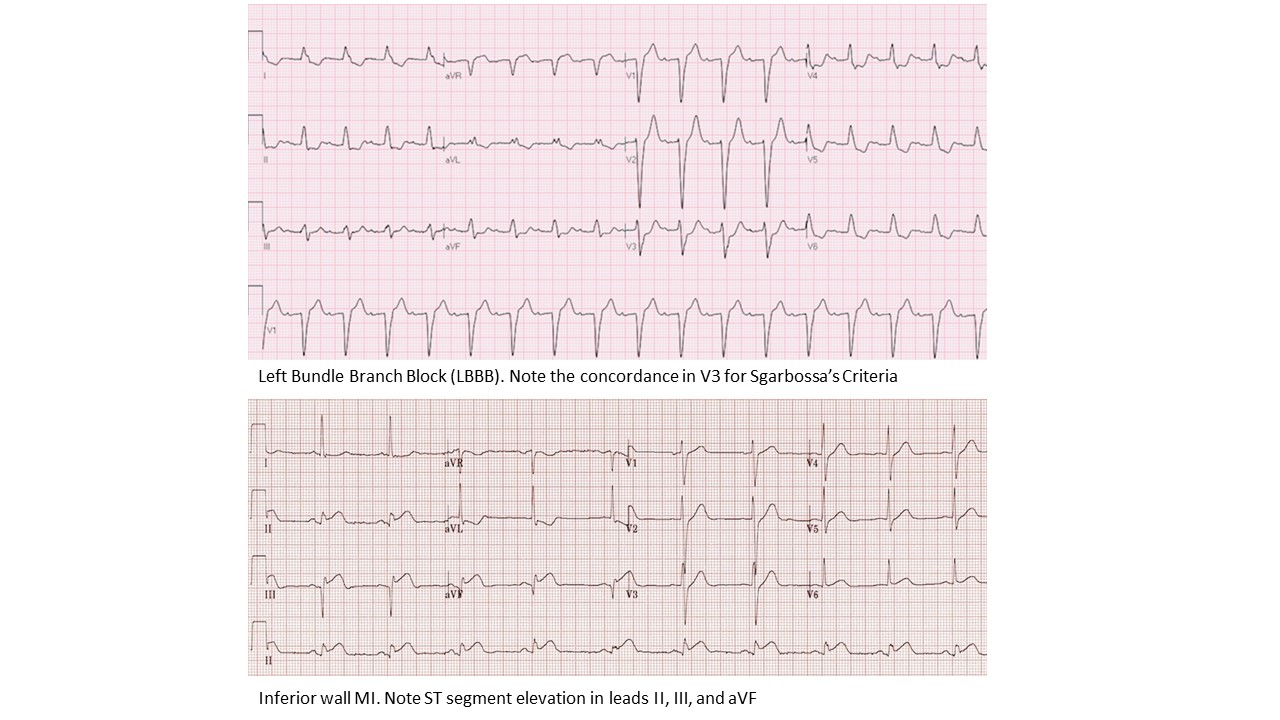[1]
Francia P, Balla C, Paneni F, Volpe M. Left bundle-branch block--pathophysiology, prognosis, and clinical management. Clinical cardiology. 2007 Mar:30(3):110-5
[PubMed PMID: 17385703]
[2]
O'Gara PT, Kushner FG, Ascheim DD, Casey DE Jr, Chung MK, de Lemos JA, Ettinger SM, Fang JC, Fesmire FM, Franklin BA, Granger CB, Krumholz HM, Linderbaum JA, Morrow DA, Newby LK, Ornato JP, Ou N, Radford MJ, Tamis-Holland JE, Tommaso CL, Tracy CM, Woo YJ, Zhao DX. 2013 ACCF/AHA guideline for the management of ST-elevation myocardial infarction: a report of the American College of Cardiology Foundation/American Heart Association Task Force on Practice Guidelines. Journal of the American College of Cardiology. 2013 Jan 29:61(4):e78-e140. doi: 10.1016/j.jacc.2012.11.019. Epub 2012 Dec 17
[PubMed PMID: 23256914]
Level 1 (high-level) evidence
[3]
Sgarbossa EB, Pinski SL, Barbagelata A, Underwood DA, Gates KB, Topol EJ, Califf RM, Wagner GS. Electrocardiographic diagnosis of evolving acute myocardial infarction in the presence of left bundle-branch block. GUSTO-1 (Global Utilization of Streptokinase and Tissue Plasminogen Activator for Occluded Coronary Arteries) Investigators. The New England journal of medicine. 1996 Feb 22:334(8):481-7
[PubMed PMID: 8559200]
[4]
Meyers HP, Limkakeng AT Jr, Jaffa EJ, Patel A, Theiling BJ, Rezaie SR, Stewart T, Zhuang C, Pera VK, Smith SW. Validation of the modified Sgarbossa criteria for acute coronary occlusion in the setting of left bundle branch block: A retrospective case-control study. American heart journal. 2015 Dec:170(6):1255-64. doi: 10.1016/j.ahj.2015.09.005. Epub 2015 Sep 24
[PubMed PMID: 26678648]
Level 2 (mid-level) evidence
[5]
Clark AL, Goode K, Cleland JG. The prevalence and incidence of left bundle branch block in ambulant patients with chronic heart failure. European journal of heart failure. 2008 Jul:10(7):696-702. doi: 10.1016/j.ejheart.2008.05.001. Epub 2008 May 22
[PubMed PMID: 18501670]
[6]
Nikoo MH, Aslani A, Jorat MV. LBBB: State-of-the-Art Criteria. International cardiovascular research journal. 2013 Jun:7(2):39-40
[PubMed PMID: 24757618]
[7]
Yancy CW, Jessup M, Bozkurt B, Butler J, Casey DE Jr, Drazner MH, Fonarow GC, Geraci SA, Horwich T, Januzzi JL, Johnson MR, Kasper EK, Levy WC, Masoudi FA, McBride PE, McMurray JJ, Mitchell JE, Peterson PN, Riegel B, Sam F, Stevenson LW, Tang WH, Tsai EJ, Wilkoff BL, American College of Cardiology Foundation, American Heart Association Task Force on Practice Guidelines. 2013 ACCF/AHA guideline for the management of heart failure: a report of the American College of Cardiology Foundation/American Heart Association Task Force on Practice Guidelines. Journal of the American College of Cardiology. 2013 Oct 15:62(16):e147-239. doi: 10.1016/j.jacc.2013.05.019. Epub 2013 Jun 5
[PubMed PMID: 23747642]
Level 3 (low-level) evidence
[8]
Dambrink JH, Dambrink JH. Left bundle branch block and private pilot licensing. Aviation, space, and environmental medicine. 2003 Dec:74(12):1292-6
[PubMed PMID: 14692475]
Level 3 (low-level) evidence
[9]
Ezzeddine FM, Dandamudi G. Updates on His bundle pacing: The road more traveled lately. Trends in cardiovascular medicine. 2019 Aug:29(6):326-332. doi: 10.1016/j.tcm.2018.09.018. Epub 2018 Oct 9
[PubMed PMID: 30344079]

